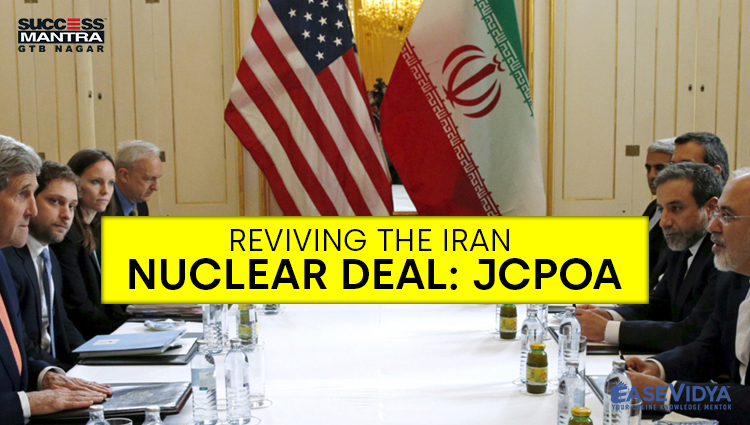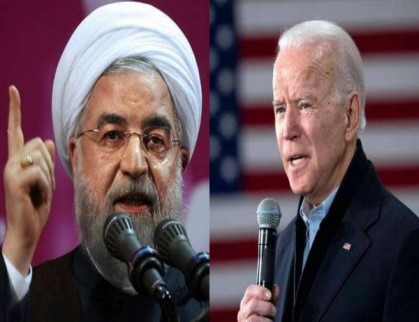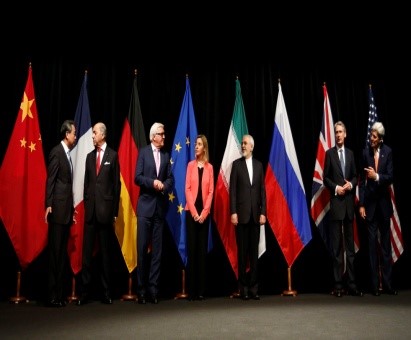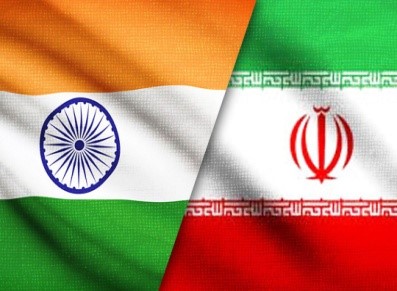
REVIVING THE IRAN NUCLEAR DEAL JCPOA
REVIVING THE IRAN NUCLEAR DEAL: JCPOA

Recently, Joe Biden has been sworn as the 46th president of the United States. On the foreign policy front, Biden has promised to move quickly to rejoin the nuclear deal with Iran which is also known as the Joint Comprehensive Plan of Action (JCPOA). JCPOA was signed in 2015, but former US President Trump has withdrawn from it (in 2018) and embarked on a policy of ‘maximum pressure’ to coerce Iran back to the negotiating table. The maximum pressure campaign devastated Iran’s economy but failed to push Iran back to the negotiating table or to curtail its involvement in Iraq, Syria, or Lebanon. Joe Biden has reiterated a return to the JCPOA provided Iran returns to full compliance. The return of the US to JCPOA may be a positive step towards regional peace. However, there are many challenges for the US and Iran to return to the negotiating table.
JCPOA: TIMELINE & BACKGROUND

The JCPOA was the result of prolonged negotiations from 2013 and 2015 between Iran and P5+1 (China, France, Germany, Russia, the United Kingdom, the United States, and the European Union, or the EU). It happened, thanks to the backchannel talks between the U.S.(U.S. President Barack Obama) and Iran, quietly brokered by Oman, in an attempt to repair the accumulated mistrust since the 1979 Islamic revolution. The JCPOA obliged Iran to accept constraints on its enrichment program verified by an intrusive inspection regime in return for a partial lifting of economic sanctions.
However, faced with a hostile Republican Senate, President Obama was unable to get the nuclear deal ratified but implemented it on the basis of periodic Executive Orders to keep sanction waivers going. When Donald Trump became president, he withdrew from the deal and called it a “horrible, one-sided deal that should have never, ever been made”. The U.S. decision was criticized by all other parties to the JCPOA (including the European allies) because Iran was in compliance with its obligations, as certified by the International Atomic Energy Agency (IAEA). Tensions rose as the U.S. pushed ahead with its unilateral sanctions, widening its scope to cover nearly all Iranian banks connected to the global financial system, industries related to metallurgy, energy, and shipping, individuals related to the defense, intelligence, and nuclear establishments. For the first year after the U.S. withdrawal, Iran’s response was muted as the E-3 (France, Germany, the U.K.) and the EU promised to find ways to mitigate the U.S. decision.
The E-3’s promised relief Instrument in Support of Trade Exchanges (INSTEX), created in 2019 to facilitate limited trade with Iran. However, by May 2019, Iran’s strategic patience ran out as the anticipated economic relief from the E-3/EU failed to materialize. As the sanctions began to hurt, Tehran shifted to a strategy of ‘maximum resistance’.
IRAN'S POLICY OF 'MAXIMUM RESISTANCE'
Beginning in May 2019, Iran began to move away from JCPOA’s constraints incrementally: exceeding the ceilings of 300kg on low-enriched uranium and 130 MT on heavy-water; raising enrichment levels from 3.67% to 4.5%; stepping up research and development on advanced centrifuges; resuming enrichment at Fordow, and violating limits on the number of centrifuges in use.
In January 2020, following the drone strike on Islamic Revolutionary Guard Corps commander Gen. Qasem Soleiman, Iran announced that it would no longer observe the JCPOA’s restraints. The collapse of the JCPOA drags Iran towards nuclear brinkmanship, like North Korea, which has created major geopolitical instability in the region and beyond.
ROADBLOCKS IN THE RESTORATION OF THE DEAL
Regional Cold War Between Iran & Saudi Arabia: Saudi Arabia is the cornerstone of US’ Middle East policy. The US has strengthened its relationship with Saudi-Arabia, to act as a counterweight against Iran. However, traditional Shia vs Sunni conflict precipitated into a regional cold war between Iran & Suadi Arabia. Thus, a major challenge for the US to restore the nuclear deal is to maintain peace between the two regional rivals.
Iran Gone too Far: The challenge in resuming the agreement in its present form is that Iran is currently in violation of several of its important commitments, such as the limits on stockpiles of enriched uranium. The International Atomic Energy Agency noted that Iran now had more than 2,440 kilograms, which is more than eight times the limit set by the 2015 nuclear deal. Further, Iran says it wants the US to pay for the billions of dollars in economic losses it incurred when it pulled the United States out of the Iran deal in 2018 and reinstituted sanctions that it had lifted.
IMPACTS ON INDIA FOR RESTORATION OF JCPOA

Restoration of JCPOA may ease many restrictions over the Iranian regime, which may directly or indirectly help India. This can be reflected in the following examples:
Boost to Regional Connectivity: Removing sanctions may revive India’s interest in the Chabahar option, Bandar Abbas port, and other plans for regional connectivity. This would further help India to neutralize the Chinese presence in Gwadar port, Pakistan. Apart from Chabahar, India’s interest in the International North-South Transit Corridor (INSTC), this runs through Iran, which will improve connectivity with five Central Asian republics, may also get a boost.
Energy Security: Due to the pressure linked to the US ’ Countering America’s Adversaries through Sanctions Act (CAATSA), India has to bring down oil imports to zero. Restoration of ties between the US and Iran will help India to procure cheap Iranian oil and aid in energy security.
CONCLUSION
The Iran nuclear deal is a joint effort by several countries. While Trump’s decision to withdraw did not kill the deal, it seriously wounded it. Like Trump, Biden would like the deal to be a key part of his administration’s vision in the Middle East – but this might be tougher than it is anticipated.
QUESTIONS (1-5)
Q.1 The Joint Comprehensive Plan of Action (JCPOA) is an Iranian Nuclear deal signed by Iran with P5+1. Which of the following countries or organisations was not included in that?
- United States of America
- European Union
- France
- India: ANSWER
Q.2 Consider the following statements and state which of the following is/are correct in reference to the Joint Comprehensive Plan of Action (JCPOA) agreement?
- As per the agreement, Iran agreed to make certain changes to its nuclear programme to ensure it does not threaten the regional stability.
- After the agreement was ratified in the year 2015 nuclear related sanctions on Iran were lifted by the US effective January 1, 2016.
- Only I follows
- Only II follows
- Both I and II are correct: ANSWER
- None is correct
Q.3 Which of the following presidents have pulled out US from the Iran nuclear deal and re-imposed sanctions on Iran?
- Donald Trump: ANSWER
- Joseph Robinette Biden Jr.
- Barack Obama
- None of the above
Q.4 Which of the following statements is incorrect in the context of the above mentioned passage?
- Restoration of JCPOA may impose many restrictions over the Iranian regime which will hamper the India-Iran relationship: ANSWER
- Traditional Shia vs Sunni conflict precipitated into a regional cold war between Iran & Suadi Arabia which act as roadblock to the JCPOA agreement.
- Through the agreement Iran can pressurize those countries to buy oils who were buying from Iran when it was not under sanctions.
- None of the above
Q.5 Which of the following projects has been developed by India in close contact with Iran to boost regional connectivity and bilateral partnership between these countries?
- Chabahar Port
- Bandar Abbas port
- Gwadar Port
- Both I & II: ANSWER












0 Comment